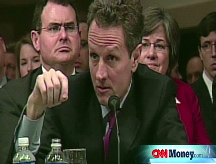Wall Street: All eyes on Washington
Investors will look to the government in the week ahead, with the bank bailout plan and stimulus package in focus.
NEW YORK (CNNMoney.com) -- Stocks broke a four-week losing streak last week on hopes that Washington's stimulus package and revamped bank rescue plan will slow the pace of the 14-month old recession.
Any dashing of those hopes this week could send stocks right back down to their recent lows, with wary investors ready to bail if the rescue plans don't go far enough. On Monday night, President Obama will hold a prime-time press conference to discuss his economic recovery initiatives.
On Tuesday, Treasury Secretary Tim Geithner is scheduled to reveal how the Obama administration plans to use the remaining $350 billion of the Treasury's $700 billion Troubled Asset Relief Program (TARP).
Geithner was originally set to unveil the plan Monday, but the Treasury Department announced Sunday it was being postponed to allow Geithner to focus on the stimulus package being debated in Congress.
Investors are also keeping an eye on the Senate's weeklong wrangling over the more than $900 billion economic stimulus plan after a different version earned party-line approval in the House of Representatives in the previous week. As of Friday night, negotiators on both sides of the aisle had reached a tentative agreement for a $780 billion package.
Congress is trying to meet its self-imposed deadline to pass the bill by the end of next week.
"It's all about Washington right now," said Brett Hammond, Chief Investment Strategist at financial services firm TIAA-CREF. "These are such unusual times that we are looking to the government for stabilization."
"We need to see some sort of stimulus package that is of a significant size and that combines tax relief, short-term spending and long-term spending," he said.
As for the TARP, he said investors need to be confident that the program is going to successfully lubricate the financial markets, and by extension, the economy.
Geithner to goose markets: This week, TARP developments could have a bigger impact on the stock market than the stimulus. Even if the Senate approves the stimulus bill, lawmakers in the House and Senate will then need to reach an agreement on the final version.
Regardless, the market has been tethered to financial stocks this year - much like it was last year -- and stocks will take their cues from the banking sector.
The broad stock market rallied on Friday despite a report showing the biggest monthly job losses in 34 years. Those gains were sparked by investor optimism about the government plans and a huge rally in the bank stocks, with the KBW Bank (BKW) index gaining 12%.
On Tuesday, Geithner is expected to unveil the Obama administration's plan to revive the banking system, including the overhaul of the controversial TARP program. Economists expect the government will need more than the $350 billion remaining funds to stabilize the banking system.
The new plan could include the creation of an aggregator bank or so-called "bad bank" that would sop up bad assets off bank balance sheets and ideally get the banks to start lending again.
Questions about how to value the assets have dogged the program from the beginning. One of the criticisms of the way the Bush administration handled the first half of the TARP is that the Treasury overpaid for the bad assets.
So as to address these concerns, the government could choose to suspend or alter the "mark-to-market" accounting rule, allowing the government to buy the toxic debt at a price that is below market rate, but not at fire sale prices.
"Whatever they end up doing, it's going to help the economy, but it's only going to be fair to the taxpayer if the government gets a fair price," said Len Blum, managing director at Westwood Capital.
For more details on what the new version of TARP might include, click here.
Tuesday: The government's wholesale inventories report for December is due shortly after the start of trade. Inventories are expected to have fallen 0.7% after falling 0.6% in November.
Wednesday: The December trade gap is expected to have narrowed to $37.0 billion in December from $40.4 billion in November.
Thursday: The number of Americans filing new claims for unemployment is expected to have dipped to 610,000 from 626,000 last week, which was a 26-year low.
The Commerce Department reports its January retail sales index. Sales are expected to have fallen 0.3% after falling 2.7% in December. Sales excluding volatile autos are expected to have fallen 0.4% after falling 3.1% in the previous month.
Also Thursday, the government releases its business inventories report for December. Inventories are expected to have fallen 0.6% after falling 0.7% in November.
Friday: The University of Michigan's consumer sentiment index for February is expected to have risen modestly to 61.5 from the previous month's 61.2. ![]()



